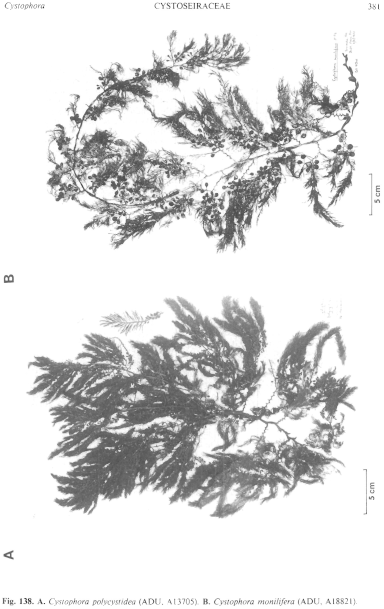|
|
|
|
|
|||||||||||
|
Electronic Flora of South Australia Species Fact Sheet
Phylum Phaeophyta – Order Fucales – Family Cystoseiraceae
Selected citations: Harvey 1863: pl. 245. Womersley 1964: 75, figs 12–14, pl. 5 fig. 1.
Thallus (Fig. 138B) medium brown, openly to moderately densely branched, 20–60 (–100) cm long, with a robust (especially below) primary axis bearing retroflex secondary axes. Holdfast discoid-conical, 0.5–2 cm across; epilithic. Primary axes with a short stipe expanding to a flat axis 3–8 (–15) mm broad and 1–2 mm thick, with narrow edges, alternately distichously branched from the face at intervals of 0.5–2 cm, with prominent residues of secondary axes on lower and mid primary axes; secondary axes (Fig. 141A) with prominent retroflex bases with broad basal wings, usually denuded above their base with scalariform residues 1–3 mm long, 2–7 mm apart. Laterals (Fig. 141A) slender, 3–8 cm long, tristichously branched (Fig. 141B) with alternately subdistichous, terete, ramuli 0.2–0.5 mm in diameter. Vesicles usually present, replacing 1 or 2 (rarely more) of the basal ramuli of laterals, subspherical, petiolate, mutic, 3–6 (–8) mm in diameter.
Reproduction: Thalli monoecious. Receptacles (Fig. 141C) branched, (0.5–) 1–2 (–3) cm long and 0.5–1 mm in diameter at conceptacles, with scattered conceptacles narrowly to distantly separated by sterile tissue, drying moniliform. Conceptacles bisexual or unisexual, with ostioles scattered or more or less in two rows in plane of branching; oogonia sessile, subspherical to ovoid, 80–120 µm long and 60–11011m in diameter; antheridia sessile or on branched paraphyses, elongate-ovoid, 20–30 µm long and 7–12 µm in diameter.
Type from W. Aust. (Preiss); in Herb. Agardh, LD, 1023.
Selected specimens: Nickol Bay, W. Aust. (1880; Herb. Sonder, MEL, 327). Champion Bay, W. Aust. (Alg. Muell., MEL, 330). Geographe Bay, W. Aust. (Bunbury, 1880; MEL, 304). Northern Great Australian Bight, S. Aust., 42 m deep (Symond, 5.v.1973; ADU, A43515). Memory Cove, S. of Port Lincoln, S. Aust., 0–5 m deep (Womersley, 25.ii.1959; ADU, A22298). Snapper Point, Port Lincoln, S. Aust., 6–8 m deep (Baldock, 1.i.1964; ADU, A27084). Port Neill, S. Aust., drift (Womersley, 3.i.1951; ADU, A13821). Marino, S. Aust., drift (Womersley, 18.vi.1963; ADU, A26869). Vivonne Bay, Kangaroo I., S. Aust., drift ( Womersley, 25.i.1948; ADU, A6756). Antechamber Bay, Kangaroo I., S. Aust., drift ( Womersley, 25.i.1948; ADU, A6756). Portland Bay, Vic., drift (Beauglehole 354, 8.vii.1951; ADU, A21802). Sorrento, Vic., drift (Womersley, 2.vi.1953; ADU, A18821). Low Head, Tas. (Perrin & Lucas, April 1932; Lucas Herb., NSW). Pebbly Beach, 20 km N. of Batemans Bay, N.S.W., drift ( Womersley, 24.i.1964; ADU, A28046).
Distribution: From Nickol Bay, W. Aust. around southern Australia and the north coast of Tasmania to Long Bay, N.S.W. (May 1939, p. 205).
Taxonomic notes: Well developed specimens of C. monilifera are characterised by the large, subspherical vesicles, the distinct wings to the base of the secondary axes and their residues, the moniliform receptacles, and the tristichous branching of the laterals. Sterile and young specimens, often with relatively small vesicles, usually show the basal, broad, wings on the secondary axes, but are more difficult to determine with certainty.
C. monilifera is a widespread species, from (0.5–) 2–42 m deep on coasts of considerable to moderate water movement.
References:
AGARDH, J.G. (1848). Species, Genera et Ordines Algarum. Vol. 1. (Gleerup: Lund.)
AGARDH, J.G. (1896). Analecta Algologica. Cont. III. Ada Univ. lund. 32, 1–140, Plate 1.
HARVEY, W.H. (1863). Phycologia Australica. Vol. 5, Plates 241–300, synop., pp. 1–73. (Reeve: London.)
MAY, V. (1939). A key to the marine algae of New South Wales. Part. II. Melanophyceae (Phaeophyceae). Proc. Linn. Soc. N.S.W. 64, 191–215.
WOMERSLEY, H.B.S. (1964). The morphology and taxonomy of Cystophora and related genera (Phaeophyta). Aust. J. Bot. 12, 53–110, Plates 1–16.
The Marine Benthic Flora of Southern Australia Part II complete list of references.
Publication:
Womersley, H.B.S. (14 December, 1987)
The Marine Benthic Flora of Southern Australia
Part II
©Board of the Botanic Gardens and State Herbarium, Government of South Australia
Illustrations in Womersley Part II, 1997: FIGS 138B, 141 A–C.

Figure 138 enlarge
Fig. 138. A. Cystophora polycystidea (ADU, A13705). B. Cystophora monilifera (ADU, A18821).

Figure 141 enlarge
Fig. 141. Receptacles of species of Cystophora. A–C. Cystophora monilifera (ADU, A26869). A. A secondary axis with laterals and vesicles. B. An axis apex with a young, tristichously branched, lateral. C. Receptacles. D–F. Cystophora expansa (D, ADU, A26898; E, ADU, A18658; F, ADU, A23133). D. A secondary axis with laterals. E,F. Laterals with receptacles. G. Cystophora torulosa (ADU, A57472). Receptacles.

|
Email Contact: State Herbarium of South Australia |

|